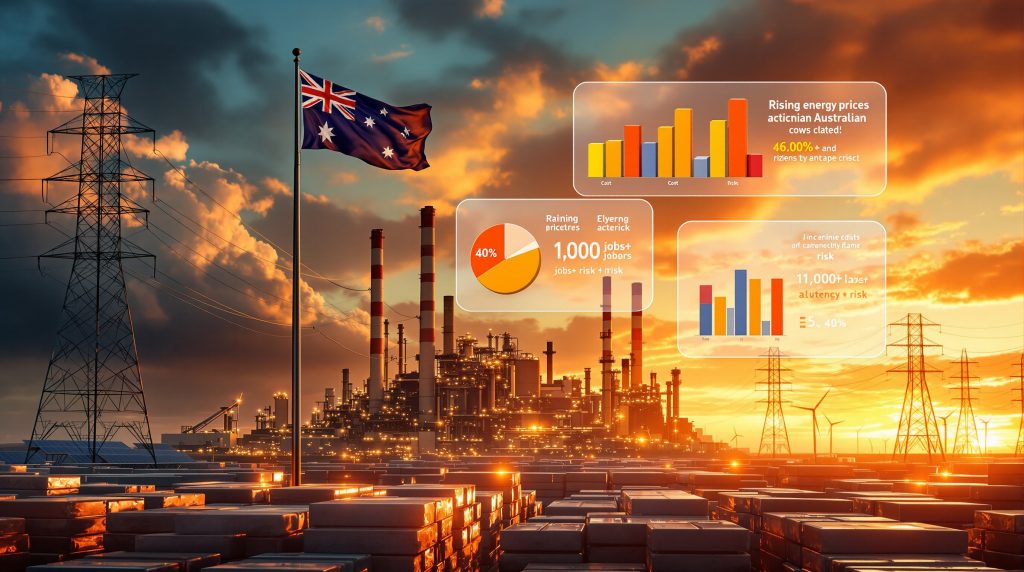Understanding Australia's Energy Crisis Through Tomago Aluminium's Dilemma
The potential closure of Tomago Aluminium represents more than just another industrial casualty of rising Tomago Aluminium closure energy costs. This situation illuminates the profound challenges facing energy-intensive manufacturing in Australia's evolving electricity market, where the energy transition and security creates both opportunities and obstacles for heavy industry.
Located approximately 13 kilometers west of Newcastle, New South Wales, Tomago Aluminium has operated as Australia's largest aluminum smelter since 1983. The facility produces up to 590,000 tonnes annually, representing nearly 40% of Australia's total aluminum output. This massive operation requires continuous electricity supply equivalent to powering a medium-sized city, making it one of the most energy-dependent industrial facilities in the Southern Hemisphere.
The Economics of Energy-Intensive Aluminum Production
Aluminum smelting demands extraordinary amounts of electricity due to the electrolytic reduction process that transforms alumina into metallic aluminum. Modern smelters typically consume 13-15 megawatt-hours per tonne of aluminum produced, with Tomago requiring over 850 megawatts of continuous power. This energy intensity makes electricity costs the dominant factor in operational viability.
According to industry analysis, electricity accounts for more than 40% of Tomago's operating costs. This proportion significantly exceeds most manufacturing industries, where energy typically represents 5-15% of total expenses. The overwhelming dependence on affordable electricity creates extreme vulnerability to power price fluctuations.
Key Economic Factors:
- Annual electricity consumption exceeding 7.4 terawatt-hours
- Power costs representing the largest single operational expense
- Profit margins typically ranging between 5-8% during favorable conditions
- Fixed operational costs requiring continuous production to maintain efficiency
Furthermore, the joint venture structure adds complexity to decision-making processes. Rio Tinto holds 51.55% ownership, while Gove Aluminium Finance controls 36.05% and Norsk Hydro maintains 12.40%. This ownership distribution requires consensus among international partners with varying strategic priorities and risk tolerances.
Critical Timeline Pressures and Market Dynamics
The urgency surrounding Tomago's situation stems from the December 2028 expiration of current power contracts. Industry sources indicate that replacement contracts under consideration would fundamentally alter the facility's economic viability. CEO Jérôme Dozol has emphasised that market proposals received demonstrate future energy prices would not support commercially sustainable operations.
Timeline Factors:
- Current power contract expires: December 2028
- Consultation period concludes: November 21, 2025
- Lead time for alternative energy arrangements: 2-3 years minimum
- Renewable energy project development timeframes: 3-5 years typically
The compressed timeline creates additional pressure, as large-scale renewable energy projects require substantial lead times for development, permitting, and grid connection. This temporal mismatch between contract expiration and renewable energy availability represents a critical challenge for energy-intensive industries transitioning away from coal-fired power.
Australia's Electricity Market Structure and Industrial Implications
Australia's National Electricity Market operates as a competitive wholesale system where prices fluctuate based on real-time supply and demand dynamics. Large industrial users typically secure long-term power purchase agreements to avoid spot market volatility, but contract renewals reflect prevailing market conditions and future price expectations.
However, the resource energy export challenges facing Australia create additional complexity for domestic industrial users. The retirement of aging coal-fired power stations creates supply constraints that drive wholesale electricity prices higher.
Regional Price Variations (Industrial Users):
| State/Region | Average Rate Range (c/kWh) | Market Trend |
|---|---|---|
| New South Wales | 12-18 | Increasing |
| Victoria | 10-16 | Increasing |
| Queensland | 8-14 | Stable |
| South Australia | 14-22 | Volatile |
Simultaneously, renewable energy integration requires substantial grid infrastructure investments and backup systems to ensure supply reliability for continuous industrial processes.
Grid Stability Requirements:
- Baseload demand: 24/7 consistent supply without interruption
- Voltage stability: Fluctuations can damage sensitive smelting equipment
- Frequency control: Industrial processes require precise electrical characteristics
- Backup systems: Redundant supply arrangements for operational continuity
Employment and Regional Economic Consequences
The potential closure extends far beyond direct employment impacts. Tomago Aluminium directly employs approximately 1,000 workers with salaries significantly above regional averages. The facility's annual payroll exceeds $100 million, creating substantial economic multiplier effects throughout the Hunter Valley region.
Economic Impact Analysis:
- Direct employment: 1,000+ positions at risk
- Average salary: $100,000+ annually
- Total payroll: $100+ million per year
- Indirect jobs: 2,000-3,000 supply chain positions
- Regional procurement: $50+ million annually in local purchases
The broader supply chain implications affect transportation, maintenance, raw materials supply, and professional services. Local businesses dependent on employee spending would experience reduced revenue, while regional housing markets could face downward pressure from population outmigration.
What Does This Mean for Regional Communities?
Industrial facilities like Tomago serve as economic anchors for regional communities, providing high-paying jobs that support local businesses and infrastructure. The loss of such facilities often triggers regional decline cycles that prove difficult to reverse.
Alternative Energy Solutions and Implementation Challenges
Several alternative energy arrangements could potentially support continued operations, though each presents distinct challenges and requirements:
Direct Power Purchase Agreements (PPAs):
- Long-term contracts with wind/solar developers
- Price certainty over 10-20 year terms
- Require substantial renewable energy capacity
- Need grid connection and transmission infrastructure
Hybrid Energy Systems:
- Combination of renewable sources with storage
- Grid-tied backup for supply security
- Higher capital costs but improved reliability
- Emerging technology with limited large-scale precedents
Industrial Energy Storage:
- Large-scale battery systems for load balancing
- Peak shaving during high-price periods
- Technology costs declining but still substantial
- Limited commercial deployment at required scale
The scale requirements present particular challenges. Tomago's electricity demand equals approximately 850 megawatts of continuous generation capacity. This requirement exceeds many individual wind farms or solar installations, necessitating either multiple renewable energy partnerships or dedicated large-scale developments.
Global Industry Responses to Energy Transitions
International Precedents:
Aluminium smelters worldwide face similar energy transition pressures, with varying responses based on local market conditions and policy frameworks:
European Market Adjustments:
- Production curtailments during 2022-2023 energy crisis
- Shift toward specialty aluminium products with higher margins
- Increased recycling operations to reduce primary production
- Government support programs for industrial energy transitions
North American Strategies:
- Strategic partnerships with hydroelectric power sources
- Direct investments in renewable energy projects
- Technology upgrades to improve energy efficiency
- Carbon pricing mechanisms creating competitive dynamics
Asian Market Dynamics:
- State-controlled energy pricing in some jurisdictions
- Massive scale economies reducing per-unit costs
- Environmental regulations driving efficiency improvements
- Vertical integration strategies including power generation
Technology and Efficiency Innovations
Modern aluminium production increasingly incorporates efficiency improvements that reduce energy consumption per tonne of output:
- Prebaked anode technology: Reduces energy consumption by 5-10%
- Advanced process control systems: Optimise electrical efficiency
- Heat recovery systems: Capture and utilise waste energy
- Inert anode research: Potential 15-20% energy reduction (developmental stage)
Energy Management Systems
- Load flexibility: Adjusting production during peak price periods
- Demand response participation: Grid services revenue streams
- Power quality improvements: Reducing electrical losses
- Predictive maintenance: Minimising efficiency degradation
Consequently, these technological approaches could potentially offset some Tomago Aluminium closure energy costs, though implementation requires substantial capital investment and operational modifications.
Policy Framework Considerations
Various policy tools exist to support industrial energy transitions while maintaining economic competitiveness. For instance, government intervention policies can provide crucial support during transition periods.
Financial Support Instruments:
- Industrial transformation grants: Capital funding for efficiency upgrades
- Loan guarantee programmes: Risk sharing for renewable energy investments
- Accelerated depreciation: Tax incentives for clean technology adoption
- Power price stabilisation schemes: Market intervention mechanisms
Regulatory Framework Adjustments:
- Renewable Energy Zones: Dedicated transmission for industrial users
- Industrial energy certificates: Tradeable instruments for large users
- Grid connection priority: Fast-tracking renewable energy connections
- Carbon border adjustments: Protection from unfair international competition
Governments must balance environmental objectives with industrial competitiveness, ensuring energy transitions don't simply export manufacturing and emissions to jurisdictions with less stringent environmental standards.
Market Psychology and Investment Implications
The Tomago situation reflects broader market uncertainties affecting energy-intensive industries globally. Investment decisions increasingly incorporate long-term energy price assumptions and carbon pricing expectations.
Risk Assessment Considerations:
- Stranded asset potential: Facilities becoming uneconomical before depreciation
- Regulatory uncertainty: Changing environmental and energy policies
- Technology disruption: Breakthrough innovations altering cost structures
- International competition: Jurisdictions with different energy cost structures
Capital Allocation Strategies:
- Geographic diversification: Spreading operations across multiple markets
- Technology hedging: Investing in multiple efficiency improvement approaches
- Flexibility premiums: Valuing operational adaptability
- Partnership models: Risk sharing with energy providers and governments
Strategic Implications for Australia's Industrial Future
How Will This Affect Manufacturing Competitiveness?
The Tomago Aluminium closure energy costs consideration signals broader questions about Australia's industrial strategy in a carbon-constrained global economy. In addition to immediate concerns, this situation reflects broader industry evolution trends shaping Australia's manufacturing landscape.
Economic Diversification Opportunities:
- Advanced manufacturing: Higher-value, less energy-intensive production
- Circular economy development: Enhanced recycling and reprocessing capabilities
- Clean technology manufacturing: Renewable energy components and systems
- Critical minerals processing: Value-added mineral processing for energy transition
Supply Chain Security Implications:
- Import dependence: Reduced domestic aluminium production capacity
- Strategic reserves: Government stockpiling considerations
- Alternative suppliers: Reliability and cost of international sources
- Downstream industry impacts: Construction, automotive, and packaging sectors
Furthermore, Australia's critical minerals reserve strategy must account for reduced domestic processing capacity if facilities like Tomago close.
Lessons for Energy-Intensive Industries
The Tomago situation provides valuable insights for other energy-intensive industries navigating similar transitions:
Early Action Requirements:
- Long-term energy planning: Beginning transition strategies 5-7 years before contract expiry
- Stakeholder engagement: Involving governments, communities, and workers early
- Technology roadmapping: Systematic evaluation of efficiency improvement options
- Market intelligence: Continuous monitoring of global industry developments
Operational Flexibility Development:
- Load management capabilities: Ability to adjust production during price spikes
- Multiple supply arrangements: Diversified energy procurement strategies
- Efficiency optimisation: Continuous improvement programmes
- Product portfolio adaptation: Shifting toward higher-value, lower-energy products
Risk Mitigation Frameworks:
| Risk Category | Mitigation Strategy | Implementation Timeline |
|---|---|---|
| Energy Price Volatility | Long-term contracts, hedging | 2-3 years |
| Supply Security | Multiple suppliers, storage | 1-2 years |
| Regulatory Changes | Stakeholder engagement, compliance planning | Ongoing |
| Technology Disruption | R&D investment, partnerships | 3-5 years |
Looking Forward: The Path Ahead
According to recent reports from The Guardian, the federal government is actively engaged in discussions with Tomago's owners regarding potential solutions. However, the complexity of Tomago Aluminium closure energy costs requires comprehensive policy responses beyond immediate crisis management.
The ultimate resolution will likely influence policy approaches and business strategies across Australia's energy-intensive manufacturing sector. As Australia continues its energy transition, finding viable solutions for existing industrial facilities remains crucial for maintaining both environmental objectives and economic competitiveness.
Disclaimer: This analysis is based on publicly available information and industry data as of October 2025. Energy market conditions, policy frameworks, and technology costs continue to evolve rapidly. Readers should seek current information and professional advice for specific investment or business decisions.
Looking to Invest in Australia's Energy Transition Opportunities?
Discovery Alert's proprietary Discovery IQ model delivers real-time alerts on significant ASX mineral discoveries, including critical minerals essential for renewable energy infrastructure that could benefit from situations like Tomago's energy challenges. Begin your 30-day free trial today to position yourself ahead of the market and identify actionable opportunities in the evolving energy sector.




